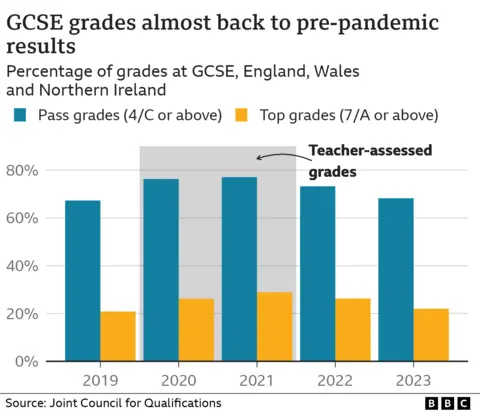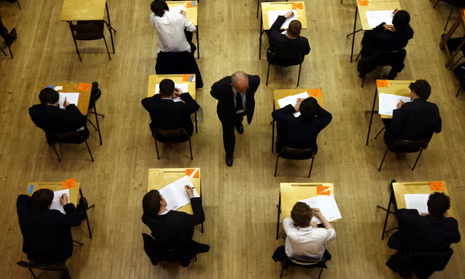
In England, the results reveal a wide range of differences, while the percentage of students receiving top grades in Wales and Northern Ireland decreases.
The effects of the COVID epidemic have been minimised in England’s GCSE results, with 16-year-olds receiving grades that are comparable to those they obtained the previous year and just slightly higher than the levels they had achieved before the pandemic.
There were significant regional differences in the outcomes across England, with pupils in London achieving grades that were higher than those they had achieved before the pandemic. On the other hand, the highest scores in Wales and Northern Ireland experienced a decline when compared to the previous year.
With 70.4% of entries by students in year 11 receiving a grade 4—which is equivalent to a C—or better, the results of this year have been welcomed as a return to consistency by Ian Bauckham, the head of Ofqual, the examinations regulator in England. This achievement is slightly higher than the 70.3% that was achieved in 2023 and is half a percentage point higher than the results of 2019.
“It is evidence that we have settled back into a pattern of dependable and trustworthy results,” Bauckham stated while referring to the situation.
Students want the opportunity to exhibit what they know, understand, and are capable of doing, and they want their final qualification mark to appropriately represent this. Exams and assessments are challenging for students, but they desire the opportunity to demonstrate a lot of things.
Students, employers, and educators in England can have confidence in these results since the United Kingdom’s examination system has once again delivered on its promise.
The education secretary, Bridget Phillipson, made the following statement: “These students have demonstrated remarkable resilience and determination, defying unprecedented disruption throughout the pandemic, Raac [concrete], and strike action.”
“We are aware that the results of this week are likely to reveal the same inexcusable and deeply rooted regional discrepancies that we have witnessed throughout the years multiple times. Because of this, we are dedicated to removing obstacles that prevent people from taking advantage of opportunities, including by providing a curriculum that is more comprehensive and comprehensive, and to ensuring that young people in every region of our nation are able to realise their full potential.

5.1% of the more than 5 million courses that 16-year-olds in England took were awarded the highest mark of 9, which is a fraction higher than 2023. On the other hand, the proportion of students who received a grade of 7 or above, which is comparable to an A, remained the same at 22.6% in 2023 and was higher than the 21.8% that was awarded in 2019.
The regulators in Wales and Northern Ireland decided to proceed with a more gradual development from the higher levels of awards made by teacher assessment during the pandemic years of 2020 and 2021, when there were no formal examinations. During the previous year, England reverted back to the pre-pandemic grading system.
Because of this, the percentage of students in Northern Ireland who received grades of A*s and As fell from 35.1% to 31%, while the percentage of students who received grades of C or higher fell from 87% to 82.4%.
The number of students in Wales who received C grades decreased from 65.6% to 63.2%, which was lower than in 2019. The percentage of students who received A* and A marks at the highest level fell from 22% in 2023 to 19.4%.
The cabinet secretary for education in Wales, Lynne Neagle, made the following statement: “This year is our final step back towards pre-pandemic exam arrangements, and today’s results are where we expected them to be with outcomes similar to 2019.”
In addition, I would want to express my gratitude to our educators and the education workforce for the tremendous amount of effort they have put in to ensure the success of our students.
The results of the compulsory subject maths in England, where almost 800,000 pupils in the eleventh grade took the examinations, were comparable to those of the previous year. However, there was a little improvement in the performance of males, as they gained 22.5% of grades 7 and higher.
The overall percentage of girls in England who achieved the highest grade 9 was 5.8%, while the percentage of boys who received the highest grade was 4.3%.
But among students in England who were taking English literature classes, there was a significant decrease in the number of students who achieved grades of five or higher. This is a drop of one full percentage point to 56.9% when compared to the previous year, but it is only marginally lower than in 2019.

Additionally, 200,000 students will receive results for BTec courses, and around 120,000 students will receive results for Cambridge Nationals degrees. These results are in addition to the results for GCSE grades.
Although he congratulated students on their achievements, Pepe Di’lasio, the general secretary of the Association of School and College Leaders, issued a warning: “This is not the story in England for a significant proportion of students who fall short of achieving at least a grade 4 GCSE pass in English and maths, and as a result, they will be consigned to a remorseless treadmill of resits in post-16 education in accordance with rules drawn up by the previous government.”
“As the results of this year’s examinations demonstrate, the majority of these pupils have once again failed to meet the criterion for grade 4 in their retakes. As a result, this is extremely disheartening.
“It is of the utmost importance that the government’s review of the curriculum and assessment take into consideration ways in which we can improve the situation for these young people. A good place to begin would be to eliminate the requirements that require students to take multiple exams.”